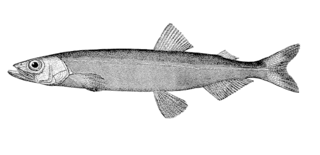
Smelts are a family of small fish, the Osmeridae, found in the North Atlantic and North Pacific Oceans, as well as rivers, streams and lakes in Europe, North America and Northeast Asia. They are also known as freshwater smelts or typical smelts to distinguish them from the related Argentinidae, Bathylagidae, and Retropinnidae.

The Osmeriformes are an order of ray-finned fish that includes the true or freshwater smelts and allies, such as the galaxiids and noodlefishes; they are also collectively called osmeriforms. They belong to the teleost superorder Protacanthopterygii, which also includes pike and salmon, among others. The order's name means "smelt-shaped", from Osmerus + the standard fish order suffix "-formes". It ultimately derives from Ancient Greek osmé + Latin forma, the former in reference to the characteristic aroma of the flesh of Osmerus.

The capelin or caplin is a small forage fish of the smelt family found in the North Atlantic, North Pacific, and Arctic oceans. In summer, it grazes on dense swarms of plankton at the edge of the ice shelf. Larger capelin also eat a great deal of krill and other crustaceans. Among others, whales, seals, Atlantic cod, Atlantic mackerel, squid, and seabirds prey on capelin, in particular during the spawning season while the capelin migrate south. Capelin spawn on sand and gravel bottoms or sandy beaches at the age of two to six years. When spawning on beaches, capelin have an extremely high post-spawning mortality rate which, for males, is close to 100%. Males reach 20 cm (8 in) in length, while females are up to 25.2 cm (10 in) long. They are olive-colored dorsally, shading to silver on sides. Males have a translucent ridge on both sides of their bodies. The ventral aspects of the males iridesce reddish at the time of spawn.
Whitebait (disambiguation) may refer to:

The delta smelt is an endangered slender-bodied smelt, about 5 to 7 cm long, in the family Osmeridae. Endemic to the upper Sacramento-San Joaquin Estuary of California, it mainly inhabits the freshwater-saltwater mixing zone of the estuary, except during its spawning season, when it migrates upstream to fresh water following winter "first flush" flow events. It functions as an indicator species for the overall health of the Delta's ecosystem.

The New Zealand smelt, also known as the New Zealand common smelt or New Zealand cucumber fish, is a smelt of the family Retropinnidae, found only in New Zealand at shallow depths in estuaries and rivers. Their length is between 8 and 13 cm.
Cucumberfish is a common name for several fish and may refer to:

Hypomesus is a genus of smelts (Osmeridae), consisting of five species found in the northern hemisphere.

Spirinchus is a genus of smelts (Osmeridae) from the North Pacific Ocean and adjacent streams.

The big-scale sand smelt is a species of fish in the family Atherinidae. It is a euryhaline amphidromous fish, up to 20 cm in length.
Night smelt is a true smelt of the family Osmeridae. It is native to the Pacific coast of North America.
Freshwater smelt may refer to:

The Argentiniformes are an order of ray-finned fish whose distinctness was recognized only fairly recently. In former times, they were included in the Osmeriformes as suborder Argentinoidei. That term refers only to the suborder of marine smelts and barreleyes in the classification used here, with the slickheads and allies being the Alepocephaloidei. These suborders were treated as superfamilies Argentinoidea and Alepocephaloidea, respectively, when the present group was still included in the Osmeriformes.

Hypomesus nipponensis is an important food fish native to the lakes and estuaries of Hokkaido, Japan. It has been introduced in other locations, including the San Francisco Delta of the United States. It is raised in fisheries, and is very similar in appearance to the delta smelt.
Japanese smelt may refer to:
Allosmerus is a monotypic genus of smelt. Its sole species, Allosmerus elongatus, the whitebait smelt, is an uncommon Northeast Pacific smelt, about which little is known. Originally described as both Osmerus attenuatus and O. elongatus, these two species were determined to be conspecific in 1946. The fish can grow from 7–9 inches (18–23 cm) in length, has large eyes, a greenish-gray color on its back, and a silver band along its sides. Unlike most other smelt species which generally have no enlarged teeth in the roof of their mouth, the whitebait has single large tooth in the center of its vomer, which is sometimes flanked by a smaller tooth on either side. The adult males of the species have a longer anal fin.

The Mediterranean sand smelt, Atherina hepsetus, is a species of fish in the family Atherinidae.

The sand smelt is a species of marine fish of the family Atherinidae, common in the northeastern Atlantic from the Danish straits, where it is rare, and Scotland to the Canary Islands and the western Mediterranean Sea. Sand smelt are small, pelagic fishes which are found in coastal areas and in estuaries. They are a schooling species which undertake seasonal migrations in the Atlantic. They are carnivorous and prey on small crustaceans and fish larvae. Reproduction takes place in the spring and summer, in the North Sea and the English Channel spawning takes place over midsummer.
H. japonicus may refer to:
This page is based on this
Wikipedia article Text is available under the
CC BY-SA 4.0 license; additional terms may apply.
Images, videos and audio are available under their respective licenses.









